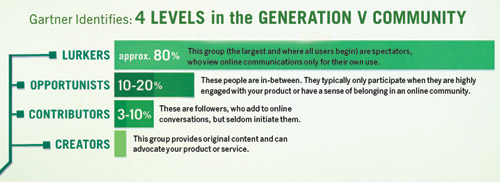Targeting specific populations is a common business practice. Whether divided by age, gender, race, geography, income, or education, there are countless ways to segment an audience. Recently, ethnographers, sociologists and cultural anthropologists have taken market segmentation a step further, attempting to attach attitudes and behaviors to societal groupings. Such “generations” are defined as periods of time in which people share collective characteristics based on cultural and societal trends prevalent of that era. In the latter-half of the 20th century, these generations are typically designated as:
1942-1953: Baby Boomers
1954-1965: Generation Jones
1966-1980: Generation X
1981-1995: Generation Y or Millennials
Numerous names have been offered for our latest generation (1996 to present), including the Text Generation, Generation Z, Generation C (for cell phone or virtual community), or the Internet Generation (often shortened to iGen or Gen@).
Recently, Gartner, Inc., a leading IT research and advisory firm, proposed a new segmentation that they’ve coined Generation V (for virtual). This segmentation is lifestyle and attitudinally oriented, cutting across demographic and generational lines. For marketers, this blended population relies primarily on digital media to discover purchase information, build knowledge and share insights. Gartner predicts that in 10 years, the largest influence on purchases will be the virtual experience associated with them.

In terms of behavior, the same person can fall into any of these four categories, based on their interest and expertise. A consumer may be passionate about their Apple iPod experience, but fall into the “Lurker” category when shopping for auto insurance.
More compelling are Gartner’s recommendations around marketing to online personas, similar to much of the current thought on “tribal marketing.”
Best practices today focus on collecting individual consumer data for one-on-one targeted marketing. However, with people creating multiple, often anonymous identities, Gartner’s premise is that companies will need to shift their focus toward understanding influencers, those that are participatory and can reflect positively on the brand.
Many companies have created online environments to facilitate information gathering, receive feedback and allow consumer-to-consumer sharing of information. Simultaneously, these same companies monitor what is being said about them in social networks and blogs. The upper echelon already know who their major influencers are.
For marketers, the shift from selling to people to selling to personas can be frightening. Online personas provide consumers opportunity for reputation, influence and accomplishment in virtual communities that may not relate to an actual person’s demographics. The leading influencer for your company’s newly released product who has identified himself as a “43 year-old male with an MBA, married with two kids and living in London” may really be a 17 year-old single female in high school in Des Moines.
Marketing to those who advocate for your brand is nothing new. Figuring out who they are online is the future frontier. Look for upcoming issues of Thinking to explore the concepts of how companies are shifting from collecting demographic data to psychographic data, as well as how to create and market to “ideal persona” models.



One Comment